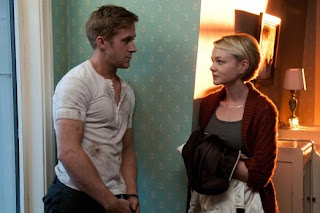Drive
The rumbling started early in the theatre, at first it was just a few snide comments here and there. By the time the credits started to role the crumbling had reached its crescendo when one viewer yelled out “this is one of the worst movies I have ever seen.” While each person is entitled to their own opinion, it was clear that the majority of the audience was anticipating a completely different film than what they got. The marketing campaign is trying to sell Drive as a film that is in the same vein as The Transporter series, when in fact it is a far slicker film noir that does not mainly rely on “fist of fury” to advance the plot.
Ryan Gosling continues his string of stirring performances as an unnamed man, referred to as “Driver”, who has an unbelievable talent when it comes to cars. Working as both a mechanic and a part-time film stunt-driver, Driver tends to keep to himself. He barely talks to his boss Shannon (Bryan Cranston). This all changes when Driver meets and falls for his next door neighbour Irene (Carey Mulligan), a single mother whose husband Standard (Oscar Isaac) is unexpectedly released from prison early. Standard owes money to some men who are threatening to harm Irene and his son Benicio (Kaden Leos), if he does not agree to rob a pawn shop. Fearing for Irene and Benicio’s safety, Driver volunteers to be Standard’s getaway driver. What Driver does not know is that the money they are about to steal belongs to local gangsters Bernie (Albert Brooks) and Nino (Ron Perlman).
Drive is very reminiscent of the action thrillers that the likes of Michael Mann and Brian De Palma use to make in the 80’s. Nicolas Winding Refn infuses the picture with his unique style which allows the film to separate itself from contemporary action films. One thing audiences will notice immediately is how little dialogue is spoken by the protagonist. While Albert Brooks and Ron Perlman play their scenes large, Gosling is always internalizing his emotions. There are numerous scenes in which Refn lets the camera quietly linger on Driver’s face as the character works things out. Having an action film that is filled with more quite moments than heart stopping action is almost unheard of in an age where action films are usually filled with loud explosions.
This is not to say that Drive is devoid of action, in fact the film has several great action scenes. The major difference here is that scenes of violence flourish as a result of the silence that often precedes it. Like most of Refn’s films the violence is brutal and unflinching, but never reaches the point of being gratuitous. Refn also keeps the action leaning towards the more realistic side of things. There is no scene where Driver is in a shootout with eight guys at once, nor is there a scene where Driver is jumping out of a building just before it explodes. The final action sequence may seem underwhelming to those expecting a standard action film ending, yet in the context of the world that Refn has created, the sequence works extremely well.
Refn is meticulous with how he orchestrates both his action scenes as well as his quieter moments. In one tense elevator scene, Driver slowly moves the unaware Irene behind him for safety. The use of lighting in this scene is brilliant. Refn first darkens the elevator to accentuate the pending violence, but then brightens the light on Irene to symbolize her character’s awakening. In the span of a few minutes Irene shares a romantic moment with Driver and also realizes his tendency towards violence. It is moments like these that make Drive such a thrill to watch.


No comments:
Post a Comment